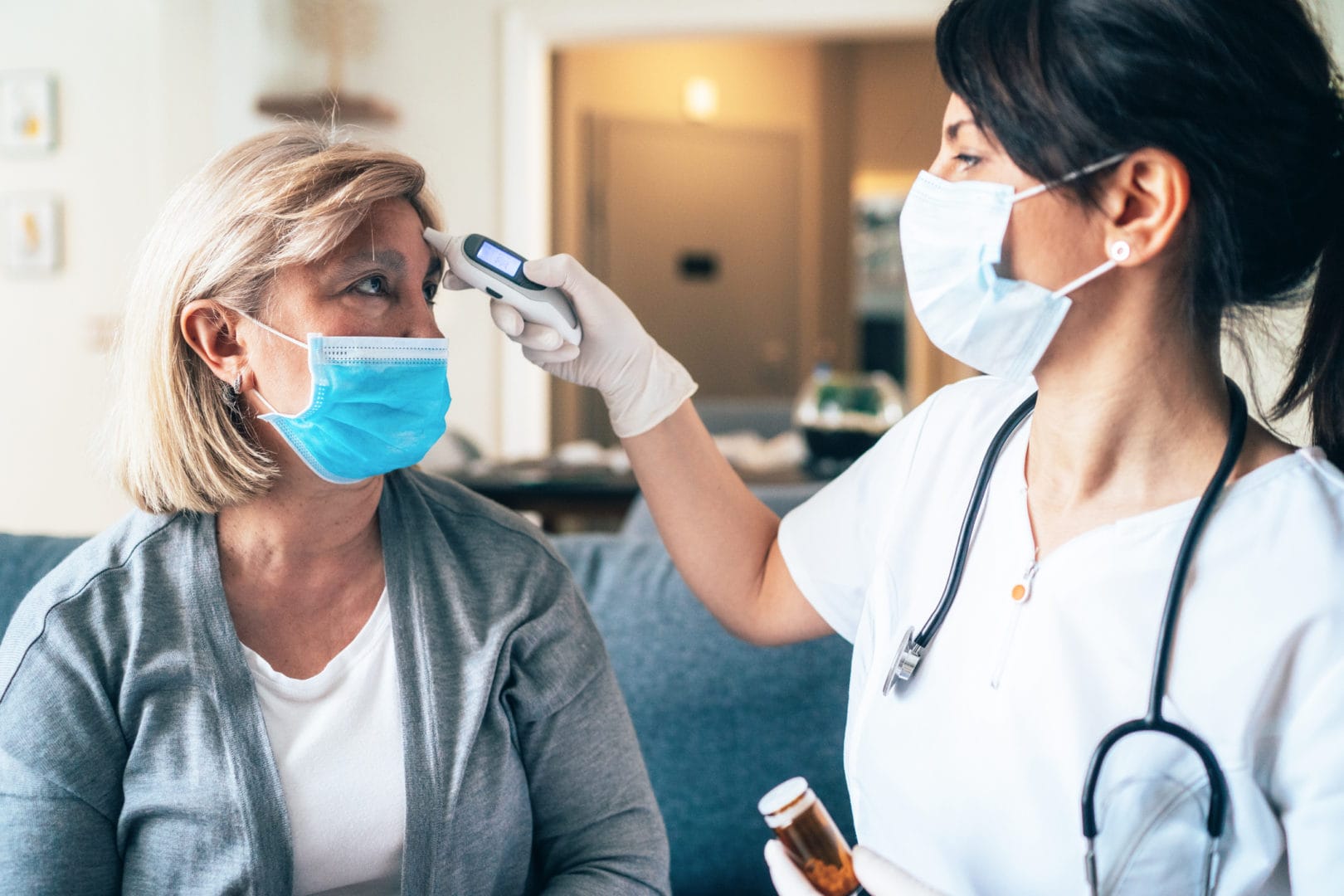You’ve likely heard that 98.6 is the body’s baseline temperature, but the fact is the number on the thermometer tends to decrease with age. In those 65 and older, fevers can even be blunted or completely absent despite an ongoing infection.
This can be particularly problematic in the colder months when viruses such as flu, RSV, COVID (and others) tend to peak. “Older adults can have all sorts of viruses and not develop a fever,” says Dr. Scott Dresden, an emergency medicine physician and director of Geriatric Emergency Department Innovations (GEDI) at Northwestern University in Chicago. “It is also common for older adults to have low body temperature when they have an infection.”
Failing to spot a virus, such as flu, in an older adult can be dangerous, notes Dresden. “Influenza is particularly dangerous for seniors,” he says. “It can lead to pneumonia and secondary infections, such as bacterial pneumonia in addition to the viral infection. Earlier diagnosis of influenza and COVID make treatments such as Tamiflu and Paxlovid more effective for patients who are vulnerable to complications, such as older adults.”
“Older adults can have all sorts of viruses and not develop a fever.”
— Dr. Scott Dresden, director of Geriatric Emergency Department Innovations
From the reason behind this phenomenon to other virus symptoms to look for, here’s everything you need to know about low body temperature in seniors.
Do older adults have lower body temperature?
“As we age, we have a slower metabolic rate and are unable to maintain normal body temperature,” explains Dr. Ivayla Geneva, an infectious disease specialist in Syracuse, New York and lead author of a systemic review on normal temperature for the elderly published in the journal Open Forum Infectious Diseases. “These changes are important clinically because we know older patients have weaker immune systems, difficulty fighting off infection and disease and often fail to reach the temperature range of what is traditionally considered a fever, anything above 100.4 F.”
A 2014 study found 20-30% of seniors with an infection come into the emergency department with a blunted fever response — in part because of a lower basal body temperature. As a result, these patients are more likely to be misdiagnosed and more frequently discharged with unrecognized health problems.
Other factors that can play a role in lower temperatures:
- Method of taking one’s temperature. Thermometer manufacturers often include specific information in the manual on how their device’s results correlate with the method you use, be that mouth (oral), anus (rectal), armpit (axillary) or ear (tympanic). For instance, an armpit reading will most often be a little lower than an oral one.
- Living in a cooler environment/seasonal changes.
- A more sedentary/inactive lifestyle.
- Malnutrition and dehydration.
- Co-existing conditions such as hypothyroidism, brain disease and kidney dysfunction.
- Thinning skin.
- Types of medications such as beta blockers and antipsychotic drugs.
How to find a baseline temperature in older adults
To find your baseline, Geneva recommends checking your, your older loved one’s or client’s temperature when you or they are feeling well and don’t have a fever. “You’ll want to take your temperature in the same spot several times over the course of a full day and see if you get consistent readings,” she says.
Doctors typically consider a temperature that’s two degrees higher than usual to be a sign of infection; fever is not the same for everyone.
The Infectious Disease Society of America has modified the definition of fever for older adults to one of the following:
- A single oral temperature over 100 degrees F.
- Two oral repeated temperatures over 99 degrees F.
- An increase in temperature of 2 degrees F over the baseline temperature.
How to most accurately measure temperature
Geneva’s research found body temperature to be influenced most by age and where on the body it is measured. “Checking for a fever with a home thermometer orally can be very misleading and unreliable,” she notes.
“Checking for a fever with a home thermometer orally can be very misleading and unreliable.”
— Dr. Ivayla Geneva, infectious disease specialist
Here’s what you need to know about each method.
Oral temperature efficacy
These readings may be affected by conditions like dementia, tongue tremors, mouth-breathing, respiratory rate or even drinking hot or cold fluids before the reading. Problems can also occur when home thermometers aren’t used as directed in their user manual.
Rectal temperature efficacy
Dresden notes the most accurate method for taking one’s temperature is rectal. In fact, a study of hospitalized patients 75 years of age and older actually found rectal temperature measurement detected fever in 86% of patients (compared with 66% orally and only 32% by under the arm).
Infrared no-touch thermometer efficacy
It is also worth knowing that many medical centers are using infrared no-touch thermometers that read temperatures from two inches away from the forehead — a precautionary move many businesses started following during the pandemic.
Although there isn’t a ton of data on their accuracy in the elderly population, one landmark study in a nursing home population found infrared tympanic temperatures were equivalent to or better than oral temperatures, correlating with rectal temperatures. However, another study in 2020 concluded non-contact infrared thermometers “may not be the most accurate device for fever mass screening during a pandemic.”
Further, the Centers for Disease Control and Prevention (CDC) notes that “non-contact infrared thermometers frequently used for health screening must be held at a certain distance from the temporal artery in the forehead to take the temperature correctly. Holding the device too far from or too close to the temporal artery affects the reading.”
In other words: It has to be done right. The CDC also has a step-by-step graphic showing how to use an infrared thermometer correctly.
Signs and symptoms caregivers should watch for
With the absence of fever as a telltale sign of infection, providers need to look to other signs and symptoms. “Delirium, itself, can be a symptom of COVID-19 in the elderly,” Dresden notes in reference to a study on the topic in the Journal of the American Medical Association (JAMA). “When caregivers tell us this, it usually gets our attention to try and figure out what’s causing it.”
There are many other conditions that can affect older adults, too. “We see many patients being brought to the hospital with symptoms that need more investigation and are difficult to diagnose on an outpatient basis,” she notes.
For example, urinary tract infections (UTIs) are common among older adults, occurring in up to 16% of women over age 65 and up to 20% of women over 80. UTIs can also cause confusion and delirium but require a urine sample to properly detect and treat.
That said, caregivers should always take note if their senior loved one or client:
- Seems “off” and not acting like themselves.
- Sleeps more than usual.
- Stops eating.
- Seems unusually apathetic or confused.
- Loses orientation to their surroundings.
- Becomes dizzy and falls.
- Stops speaking.
Dresden notes that respiratory viruses, such as RSV or influenza, can have some or all the following symptoms:
- Cough.
- Sore throat.
- Shortness of breath.
- Increased fatigue.
- Muscle aches.
- Gastrointetstinal symptoms such as nausea, vomiting and diarrhea.
If you are worried about the person you are caring for, reach out to the doctor they are most familiar with sooner rather than later to prevent an emergency.
What to communicate in an emergency
Fever is a frequent reason older adults might head to the hospital for an evaluation. Yet, clinicians in the emergency department have not previously treated their patients and do not know the nuances of what is “new” versus what is a baseline for an older adult.
If an older adult in your care is transferred to the ER from a long-term care facility or otherwise alone, Dresden says it is extremely valuable to call and try to speak with the doctor directly after they arrive. “When the nursing home calls the hospital about a patient, they will speak with the charge nurse and not the doctor,” he explains. “Unfortunately, the chain of communication can be broken despite the best attempts.”
You’ll want to fill the senior’s doctor in on their baseline temperature as well as their cognitive, functional and psychological status.
A good understanding of this background information and having a caregiving file (which includes medical details and records) will significantly help emergency providers determine whether the changes to the senior’s health are related to infection or another stressor. As a caregiver, you are their best advocate.





